I have journaled almost every night since about 2018. This personal journaling is based on reflective practice.
Daily, I write about three:
- daily challenges
- things I did well
- things I am grateful for
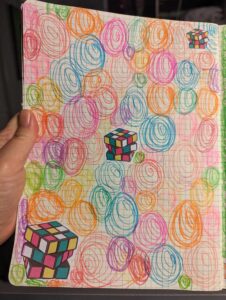
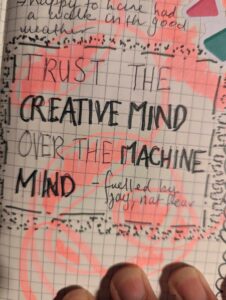
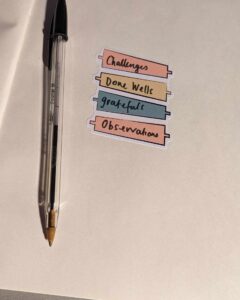
I have done this for years, but the big change came last year. It stopped only capturing my thoughts and daily reflective practice to become a massive source of creativity. I turned it into a visual arts process diary of my life and self-directed therapy by adding stickers, sketching, and colouring with coloured markers and pens. Instead of only writing, I was colouring, stickering, and decorating out my days.
The change was immediate. Journaling went from fifteen minutes that sometimes felt like home to an hour or more of creative play. I began mind mapping out problems, creating art almost every day, and felt my mind calm in ways it hadn’t done in years. During a time of intense therapy and change, this was mind-blowing.
I could feel creativity helping me navigate things. And the creative ideas that I thought had dried up because freelancing took its place started flooding back.
My creativity felt like a natural part of me again.
Extending it to freelance productivity
After I’d successfully drawn, sketched, mapped and written my way through six months, I knew this wasn’t a passing phase. And I extended the experiment into freelancing.
A fan of paper TO DO lists (and done lists), I was hoping, if nothing else, it would supercharge my productivity.
It’s done that in spades – and given me so much more.
From January (new year, new me kind of deal), I started using a Moleskine extra large soft cover journal as my map of working life.
And I can honestly say it’s helped me:
- Keep my day-to-day productivity flowing
- Stop with the self-punishment
- Make better decisions about what to spend my time on
- Create better time estimates
- Reflect on what’s important
- Capture creative and marketing ideas better
- Give an equal footing to business me and creative me
- Work on my business instead of in it
When I talk about it, everyone pipes in with their favourite software and how they use it for the same thing. I’ve done the software (to death, hey Jess!) and yes, you have found something that works but…
Something about pen and paper is soothing, far more creative, and infinitely more customisable because:
- It speaks to my inner child
- Doesn’t create constraints via UX that software often does
- Let’s me pivot easily from projects
- I don’t forget to log what is happening
- It’s created a cool down ritual
- It gets me away from the computer screen
- It’s much better reflective practice
And it also avoids the trap of focussing on getting the software right so much that it takes over actually creating anything.
Plus, a journal is a book of your achievements, a living done list you can flick through.
There’s something to be said for being tactile, messy and informal while collecting it as a living artwork that software simply cannot give you.
Want to see what I mean?
Here’s a walkthrough my journal of productivity and why it works for me
The starting blocks
When I first started the journal of productivity, I struggled. I spent a lot of time staring at the pages, trying to figure out what to write, worrying about sullying the pages. Even though I mocked up what I wanted in my other journal.
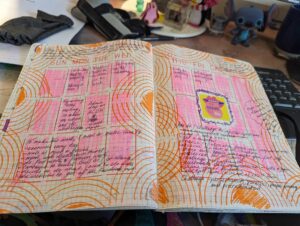
So, I started really simply.
I stuck a page from a personal journal that outlined self-care strategies on the inside cover.
On the other side, I just wrote simply: What do I want?
- To write a book
- Make Patreon sustainable
- Study my counselling diploma
- Become an authority
- Pivot Unashamedly Creative
Each bullet point got its own page. Then, the mind mapping began.
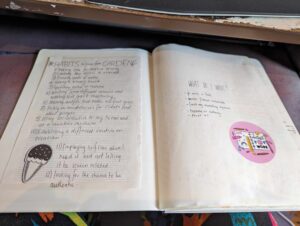
Take the goal of Make Patreon sustainable.
That became:
- Clean out and tidy old content
- Increase the value
Then, I answered How? to keep me consistent.

Beyond tidying up what was bugging and punishing me, it meant:
- Creating to a regular timetable
- Identifying what to create
- Refocussing to self-care
- Playing with new technology
- Introducing humour
- Refreshing the Patreon tiers
All Patreon creators fear the refresh. Change freaks people out, so you limp along until you can be brave enough to change. I am not stuck for ideas. I have a huge list of things to post (via post and online) and a lot of content in journals or half written that wasn’t getting anywhere. The sheer weight of ideas was overwhelming.
Hat tip goes to Magikfire, a New Zealand-based creator in my Patreon Full-time Creators Accountability Club for presenting the problem so simply.
Their system? The Creative Grind.
The management? Create, refine, edit, push.
Once I started adopting that, content production became easier.
Defining what makes it work
Next, I identified what would make me to feel good about my productivity.
That meant:
- Decluttering my ideas
- Parking less pressing ideas somewhere safe
- Collecting opportunities
The Maybe page is where I stash ideas that are nice but unnecessary, so they don’t clutter my brain.
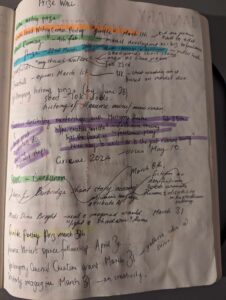 I created a Prize Wall
I created a Prize Wall
Prizes are a great way to articulate ideas by using someone else’s constraints, deadlines and funding analysis. Even if I don’t win, I am pushing an idea from my head to a plan. And that’s very beneficial because it clarifies what is worth pursuing.
On the Prize Wall, I collected:
- Creative writing prizes
- Creative grant opportunities
- Business grant opportunities
- Fellowships
And I wrote them down with the proper name (so I could Google them later) with micro descriptions about themes and the due dates.
Overview
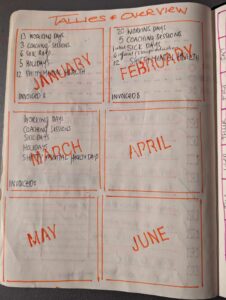 I put a very simple overview to track productivity that lists the six months from January with:
I put a very simple overview to track productivity that lists the six months from January with:
- Working days
- Coaching sessions
- Sick days
- Holidays
- Shitty mental health
- Invoiced total
This, plus the data from the Rounded tracker, has been invaluable in setting rates, recognising limitations, looking for patterns with disability management, and seeing the impact of health, time off and disability on my productivity.
Month-by-month planning
We live in a world that is volatile and changeable.
I added a hand drawn calendar in my personal journal to help track health, disability and mental health. I added one for the productivity journal that tracks:
- Appointments
- Meetings
- Key statuses
- Deadlines
- Workdays
- Non-working days
Next, I plan projects in line with the work of Gabriele Oettingen with WOOP. And then breaking that down further into monthly steps.
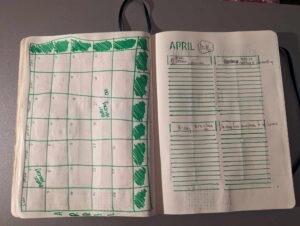
Take January – Clean up stuff month.
That involved:
- Client work
- Side project (Freelance Jungle)
- Marketing my business (Unashamedly Creative)
- Other (admin, finances, all the rest)
Using plastic templates, I made four lists:
- Organisational
- Project wise
- Admin wise
- Actual work
Leveraging gamification, everything starts with an action word.
E.g. sort out/clean out, email, etc.
I review the monthly outline when I plan the week. And at month’s end to see if I stayed on track.
Week by week
Each week on Sunday, I put on a background TV show, get out my jars of markers, my stickers and my templates and I draw the week.
- One double page lying flat gives me:
Sunday to Saturday
- A short section for meetings and appointments
- A longer section for line items
- A notes column (more on that below)
- A five-day checkbox of self-care from Monday to Friday that has grown to:
- Walk – daily exercise
- Water – hitting my three-litre minimum
- Journal – personal journalling from the night before
- Lunch – something I often forget when in the throes of creating
- Therapy – via books, cards and other tools in self-directed format
- Study – e.g. the counselling diploma
- Write – a self-care and business essential
- Fun – we all need this!

Next, I add my tasks and appointments from Outlook and Acuity.
I look at what I did last week and missed to see:
- If it’s worth carrying over
- If it’s not, ponder on why I got distracted
Decorate with stickers and we’re ready.
Why the notes column?
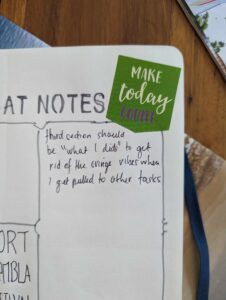 Notes help keep me on track and break away from self-punishment. I put observations about what I have planned versus where I get to, observations, scratch pad notes, and ideas that strike me as I write or work.
Notes help keep me on track and break away from self-punishment. I put observations about what I have planned versus where I get to, observations, scratch pad notes, and ideas that strike me as I write or work.
That’s helped me:
- Ignore those nagging thoughts when I can’t get everything done
- Think of really cool ideas for social media
- Capture starting lines for creative stories
- Park ideas that come but aren’t ready to be born
- Shape my productivity the next week
Gamification in action
I have addressed a few problems that I found with other systems.
DIY structure
Using my own templates helps me figure out what works without being locked into software or planner architecture that doesn’t follow the various projects I work on. Instead of trying to fit them to the software UX and line each project up with the same framework, I can design what fits that project or page.
Genuine rewards
After a while, dancing unicorns and ticking boxes bore me. With stickers, colours, notes to myself and other things, I feel like I am designing what I am in the mood to be rewarded with endless possibility.
Highlighting stuff is way more positive than drawing a line through it.
Capturing progress
Unlike software that files things away or desk pads that start fresh each week, a journal means I can flick back and forward to see what I am doing. I never lose ideas, and it enhances my daily reflective practice.
Meeting accessibility needs
As a red, green colour-deficient person with low vision, I spend a lot of frustrating time looking for things because of inaccessibility. It’s frustrating to take longer than other people to find anything.
Also, I rely on visual recall to find things. The way digital stuff looks is often the same, the visual recall is really poor.
Drawing, colouring, and decorating paper makes that so much easier. The ability to choose the colours and patterns I can see becomes even more significant when dealing with two visual disabilities.
My week is an art project
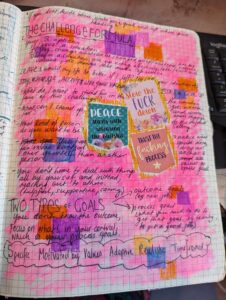
Sample of study notes
I really love things like Kurt Cobain’s journal or looking through visual process diaries of artists. This isn’t my productivity journal by any stretch.
BUT… I can see the creativity in my business unfurling and unfolding.
The way I write, I dream of the first line first. Now, I can write all the first lines I need without worrying these wordy children are lost. Or fumbling through files and folders trying to search for them.
I am also seeing productivity patterns:
- How much I can complete in a day
- How much I can complete in a week
- What distracts me
- What the interruptions look like
- What I forget to account for
My inner child is front and centre, arting, drawing, writing, stickering.
I have successfully integrated self-care into actual work. Line by line, I am teaching myself how to play and work in tandem. I’m no longer waiting to play once the never-ending work goes away.
And that is life-changing because it is enhancing my creativity, and my enthusiasm for work, marketing, side projects, writing and study.
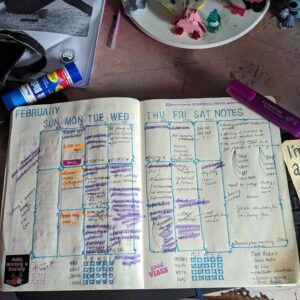
Productivity journal tips
- Use a flat lay journal so you can see the entire week. Moleskine are pricy but worth it
- Buy some plastic or card templates that suit your structure
- Don’t be afraid to experiment with the layout and let it evolve
- Draw up week by week so that the format can change with your needs
- Plan from big to small – quarter, month, week, day
- Don’t plan beyond the quarter to make it manageable
- Add things that feel like play – nice pens, markers, highlighters, washi tape, stickers, craft paper, whatever lights up your imagination that the kid inside of you loves
- Don’t be precious. Allow yourself to be more adult than kid and scribble stuff, map stuff, cross out stuff, write in the margins, etc
- Keep it for you. Having something you can Instagram for its fancy calligraphy sounds nice, but don’t put pressure on it to be a marketing activity
- Learn from what it tells you. You’ll quickly see when you’ve overestimated and when you need to divide tasks
- Be compassionate always. Imagine finding this among your stuff in a few decades’ time and what you’d like to see
I’m toying with the idea of a sit-in that can be a productivity journal crafternoon. LMK if you are interested in the comments below!
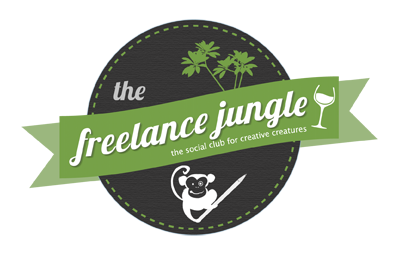
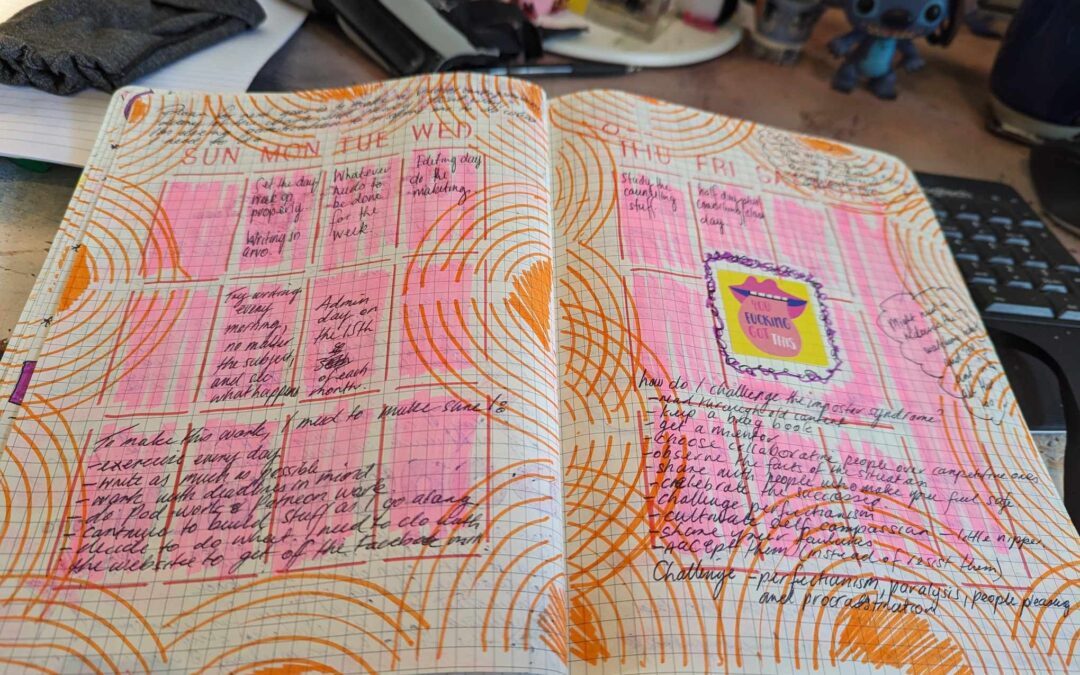
Yes please! I have several journals unused because I get overwhelmed.